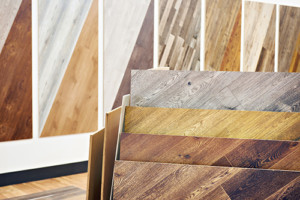 Buying a home is one of the biggest purchases, and investments, one will make in their life. That’s why every step of the process— like choosing flooring—can feel so taxing. You find yourself bombarded with questions and doubts: How much should I spend on flooring? Will this type of flooring still be trendy when I sell the house? Will it still even be intact by the time I’m ready to sell the house?
Buying a home is one of the biggest purchases, and investments, one will make in their life. That’s why every step of the process— like choosing flooring—can feel so taxing. You find yourself bombarded with questions and doubts: How much should I spend on flooring? Will this type of flooring still be trendy when I sell the house? Will it still even be intact by the time I’m ready to sell the house?
To make the process easier, we’ve included a list of pros and cons about one common type of flooring: laminate flooring. First off, let’s define what laminate flooring actually is.
What is laminate flooring?
As we’ve noted in a previous blog post, laminate flooring is a synthetic product that is made to imitate the feel and texture of natural, hardwood flooring or other materials, like stone, metal, or concrete. The composite core of laminate flooring is made of melamine resin and fiberboard with the outer layer displaying authentic, wood-like patterns and textures.
Laminate flooring has come a long way in terms of design since it was initially introduced. While in the past it may have been labeled “cheap” or “ugly,” today’s laminate is a durable, attractive alternate for the more cost-conscious buyer. Unlike solid or engineered hardwood flooring, laminate flooring is made up of layers of composite pressed (laminated) together, with a wood-grain design applique under a clear protective veneer.
Here are the pros and cons of choosing laminate flooring:
Pros:
- Durable: It’s engineered for durability, longevity, and resistance to damage. “Durable laminate is a great choice for busy playrooms,” HGTV notes.
- Low maintenance: Laminate flooring is easy to clean with minimal ongoing maintenance required. As DIY Network notes, “The wear layer of laminate floor is extremely tough, which makes cleanup and maintenance easy. Occasional sweeping keeps the surface free from abrasive grit.”
- Easy and quick to install: Much more versatile than many hardwood flooring options, laminate can be installed in almost any room of your home. Not only that, but it can be installed over existing flooring. “Lightweight, snap-together laminate flooring is installed over a thin foam cushion underlayment. That makes it a good candidate for installations over most existing flooring — with the exception of carpet — eliminating the need for tear-out,” DIY Network states. Laminate flooring can also be installed above or below grade and in other temperature-sensitive environments.
- Inexpensive: Laminate flooring has a lower cost compared to hardwood flooring styles. As Freshome states, “Not only are the materials themselves cheaper, but laminate wood installation cost is, on average, 50 percent less than hardwood installation.”
- Water and moisture-resistant: According to HomeAdvisor, modern laminate is resistant to water, spills, and heavy foot traffic, and scratches are less of an issue.
- Looks like hardwood or tile: Today, there are extensive patterns and texture options for laminate flooring. “Laminate flooring comes in a huge variety of styles, ranging from hardwood to ceramic to natural stone and tile. Modern laminate flooring is also available in a range of textures and glosses. These additional options add to laminate’s diverse aesthetics,” HomeAdvisor states.
Cons:
- Hard to repair: Laminate flooring can be hard to repair. If you buy individual pieces that snap together, you could replace individual boards, but that might be an issue too. It might not match the other boards well because of sunlight and age.
- Needs to be replaced: Laminate flooring can’t be refinished the way real wood can—once it’s worn out, it’ll have to be replaced. Check the warranty of the flooring you’re considering buying; products with higher warranties may mean better quality and longer life. Avoid cheap laminate flooring.
- Cannot sand or refinish damaged planks: Since laminate flooring is not made out of wood, you can’t sand damaged planks.
Sometimes slippery: Laminate flooring can be slippery, and so you should make sure you choose a finish that provides friction or grip. SF Gate suggests many solutions, such as applying an anti-skid product, placing carpet runners and rugs in areas of heavy traffic, or cleaning the floors with non-polishing floor cleaner. - Does not improve resale value: According to TIME, laminate won’t do much for your home’s resale value because of its lower price point. A study of homebuyer preferences by USA Today found that 54 percent of homebuyers were willing to pay more for a home with hardwood flooring.
Why Choose M Craft to Install Laminate Flooring In Your Home
If you’re considering installing laminate flooring, call M Craft today at 847-460-8477. M Craft is a family-owned business of floor installers and hardwood floor refurbishers that has served Naperville and Chicagoland for twenty years. Our flooring services include all the options to help you find the perfect combination of wood, color, and stain for your lifestyle. Call today for a laminate flooring installation estimate.






